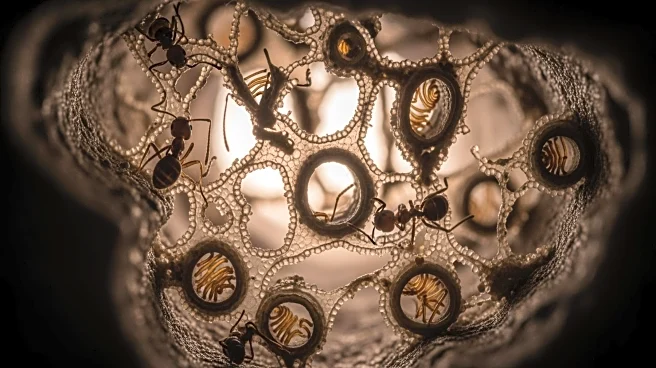What's Happening?
A recent study has revealed that black garden ants modify their nest architecture to reduce the spread of the lethal fungus Metarhizium brunneum. This fungus kills its host and transforms it into a sporulating cadaver, covered in infectious spores. Researchers,
including Nathalie Stroeymeyt from the University of Bristol, observed that ants respond to this threat by altering their social behavior and nest structure. The ants increase compartmentalization and reduce interconnectivity within their nests, effectively isolating infected individuals and minimizing interactions. This proactive approach to disease management highlights a form of 'architectural immunity' that could inspire human design strategies to prevent disease transmission.
Why It's Important?
The study of ant colonies offers valuable insights into how social species can collectively manage disease threats. By altering their environment, ants demonstrate a form of social immunity that reduces the risk of widespread infection. This concept could be applied to human architecture, particularly in public spaces, to enhance disease prevention measures. The findings suggest that strategic design changes, such as compartmentalization and controlled interaction points, could help protect vulnerable populations during epidemics. As humans continue to face challenges like pandemics, learning from these natural systems could lead to innovative solutions in urban planning and public health.
What's Next?
While the study's findings are currently too specific to ants to be directly applicable to human architecture, they open the door for future research into how these principles can be adapted for human use. Researchers may explore how compartmentalization and strategic design can be integrated into building codes and urban planning to enhance public health resilience. As the understanding of social immunity in insects grows, it could lead to new approaches in designing spaces that naturally mitigate disease spread, potentially influencing policy and construction practices.
Beyond the Headlines
The concept of architectural immunity challenges traditional views on disease management, emphasizing the role of environment in health outcomes. This approach could lead to ethical discussions about the balance between individual freedom and collective safety in public space design. Additionally, it highlights the importance of interdisciplinary research, combining ecology, architecture, and public health to address complex societal issues. As climate change and urbanization continue to impact human habitats, these insights could drive long-term shifts in how communities are structured to promote health and well-being.














